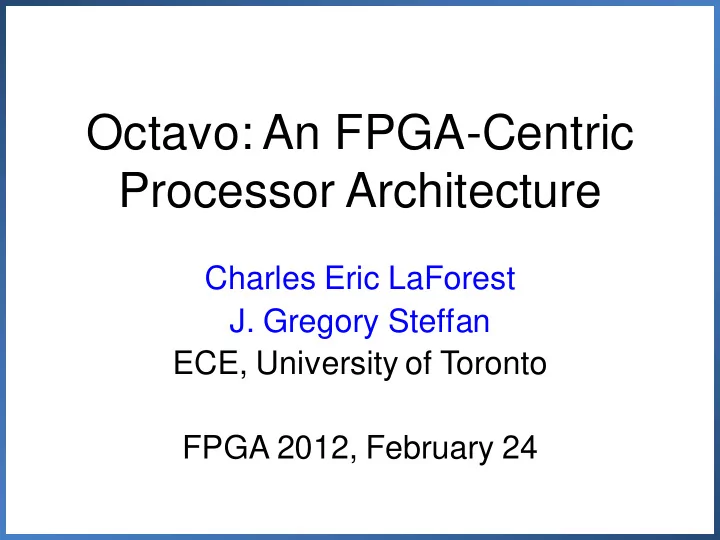

Octavo: An FPGA-Centric Processor Architecture Charles Eric LaForest J. Gregory Steffan ECE, University of Toronto FPGA 2012, February 24
Easier FPGA Programming • We focus on overlay architectures – Nios, MicroBlaze, Vector Processors • These inherited their architectures from ASICs – Easy to use with existing software tools – Performance penalty – ASIC architectures poor fit to FPGA hardware! • ASIC ≠ FPGA – ASIC: transistors, poly, vias, metal layers – FPGA: LUTs, BRAMs, DSP Blocks, routing • Fixed widths, depths, other discretizations FPGA-centric processor design? 2
How do FPGAs Want to Compute? Hardware (Stratix IV) Width (bits) Fmax (MHz) DSP Blocks 36 480 Block RAMs 36 550 ALUTs 1 800 Nios II/f 32 230 What processor architecture best fits the underlying FPGA? 3
Research Goals 1. Assume threaded data parallelism 2. Run at maximum FPGA frequency 3. Have high performance 4. Never stall 5. Aim for simple, minimal ISA 6. Match architecture to underlying FPGA 4
Result: Octavo • 10 stages, 8 threads, 550 MHz • Family of designs – Word width (8 to 72 bits) – Memory depth (2 to 32k words) – Pipeline depth (8 to 16 stages) Snapshot of work-in-progress 5
Designing Octavo 6
High-Level View of Octavo Unified registers and RAM 7
Octavo vs. Classic RISC • All memories unified (no loads/stores) • How to pipeline Octavo? 8
Design For Speed: Self-Loop Characterization 9
Self-Loop Characterization • Connect module outputs to inputs – Accounts for the FPGA interconnect • Pipeline loop paths to absorb delays • Pointed to other limits than raw delay – Minimum clock pulse widths • DSP Blocks: 480 MHz • BRAMs: 550 MHz We measured some surprising delays… 10
BRAM Self-Loop Characterization 656 MHz 531 MHz 710 MHz 398 MHz (routing!) Must connect BRAMs using registers 11
Building Octavo: Memory 12
Building Octavo: Memory 13
Memory Instruction ALU Result Replicated “scratchpad” memories with I/O while still exceeding 550 MHz limit. 14
Building Octavo: ALU 15
Building Octavo: ALU • Fully pipelined (4 stages) – Never stalls 16
Building Octavo: ALU • Multiplication – Uses DSP Blocks – Must overcome their 480 MHz limit… 17
Building Octavo: Multiplier • One multiplier is wide enough but too slow 480 MHz • Two multipliers working at half-speed – Send data to both multipliers in alternation 600 MHz 18
Octavo: Putting It All Together 19
Octavo 1 2 3 5 6 7 8 9 0 4 • Pipeline – 10 stages • Actually 8 stages with one exception (more later) – No result forwarding or pipeline interlocks – Scalar, Single-Issue, In-Order, Multi-Threaded 20
Octavo 1 2 3 5 6 7 8 9 0 4 I • Instruction Memory – Indexed by current thread PC – Provides a 3-operand instruction – On-chip BRAMs only 21
Octavo 1 2 3 5 6 7 8 9 0 4 I A/B A/B • A and B Memories – Receive operand addresses from instruction – Provide data operands to ALU and Controller • Some addresses map to I/O ports – On-chip BRAMs only 22
Octavo 1 2 3 5 6 7 8 9 0 4 I A/B A/B • Pipeline Registers – Avoid an odd number of stages – Separate BRAMs for best speed • Predicted by BRAM self-loop characterization • Unusual but essential design constraint 23
Octavo 1 2 3 5 6 7 8 9 0 4 I CTL0 CTL1 A/B A/B • Controller – Receives opcode, source/destination operands – Decides branches – Provides current PC of next thread to I memory 24
Octavo 1 2 3 5 6 7 8 9 0 4 I CTL0 CTL1 A/B A/B ALU0 ALU1 ALU2 ALU3 • ALU – Receives opcode and data – Writes result to all memories 25
Octavo T0 T1 1 T6 T7 T2 2 3 5 6 T3 7 T4 8 T5 9 0 4 I CTL0 CTL1 A/B A/B ALU0 ALU1 ALU2 ALU3 • Longest mandatory loop: 8 stages – Along A/B memories and ALU – Fill with 8 threads to avoid stalls 26
Octavo 1 2 3 5 6 7 8 9 0 4 I CTL0 CTL1 A/B A/B ALU0 ALU1 ALU2 ALU3 • Special case longest loop: 10 stages – Along instruction memory and ALU – Does not affect most computations • Adds a delay slot to subroutine and loop code 27
Results: Speed and Area 28
Experimental Framework • Quartus 10.1 targeting Stratix IV (fastest) – Optimize and place for speed – Average speed over 10 placement runs • Varied processor parameters: – Word width – Memory depth – Pipeline depth • Measure Frequency, Area, and Density 29
Maximum Operating Frequency 30
Maximum Operating Frequency Timing Slack! BRAM hard limit Faster Wider 31
Maximum Operating Frequency 550+ MHz 36 bits wide 230 MHz 32 bits wide 2.39x faster, but not a fair comparison 32
Maximum Operating Frequency Multiplier CAD Anomaly! (38 to 54 bits width) Enough pipeline stages bury the inefficiency 33
Area Density 34
Area Density 67% used 26% used (typical) “Sweet spot” 72 bits, 1024 words 35 72 bits, 4096 words
Designing Octavo: Lessons & Future Work 36
Lessons • Soft-processors can hit BRAM Fmax – Octavo: 8 threads, 10 stages, 550 MHz • Self-loop characterization for modules – Helps reason about their pipelining – Shows true operating envelopes on FPGA • Octavo spans a large design space – Significant range of widths, depths, stages Consider FPGA-centric architecture! 37
Future Work 38
Recommend
More recommend